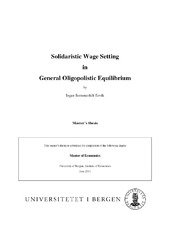| dc.description.abstract | Under the slogan "equal pay for equal work", the Scandinavian countries has strived for small wage differences between different sectors.The origin of solidaristic wage policies can be found in the 1930s, where internationally competing industrial sectors were afraid that wage claims in shielded sectors, as construction, could become too high -- and ultimately hurt the export sectors.Solidaristic wage setting appear appealing from a fairness view point, but the heighday of these politics -- the 1950s and 1960s -- also were times with rapid growth. Was this luck or coincidence? Had the Scandinavian countries discovered a winning recipe?In this thesis we will look at the welfare implication of compressed wages. The approach we have used also gives us the opportunity to look at implications of globalisation, and how globalisation and wage compression are interlinked.Wage compression will, through changes in production costs, change the distribution of production within the economy. We find that, not surprisingly, compressed real wages gives less variance of output prices across industries. This result by it self makes the consumer worse off, as the possibility of substitution towards cheaper goods is lost. What, on the other hand, is surprising, is that the compressed prices have other general equilibrium effects that are strong enough to make the end outcome higher consumer utility.When studying globalisation, wage compression has especially one noteworthy effect. When wages are not compressed, globalisation creates higher wages in all sectors. When wages are compressed, we find that in some cases globalisation will give lower wages to workers outside the unions.To investigate the issues as these, we need a model where the economy is described as imperfectly competitive (where agents act strategically) and where we can study general equilibrium effects. Models combining there traits are rare, but research is moving in this direction. When wages are compressed, this will have implications both directly as a change in production costs, and indirectly through readjustments in labour demand. Unless we can look at both partial equilibrium effects and general equilibrium effects in the same model, we could not find the dominating effect in cases where the two pull in different directions. | en_US |
